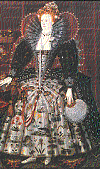EVERYDAY LIVING

The City of London
 Elizabethan London was a lively, bustling city, brought about by the political
stability of Queen Elizabeth's reign (1558-1603). In 1590, the city was an
international trade center, a popular destination for travelers, and a hub
for many sights and entertainments including dancing, music, bearbaiting,
archery, and soccer, or an afternoon at the theatre. Traveling around the
city was not always easy: narrow, smelly, muddy streets were always crowded
with people, carts and horses. Because the Thames River flowed through the
city, a faster, more pleasant mode of transportation would be taking a "wherry"
(a small river taxi) Shouts of "Westward ho!" or Eastward ho!" would be heard
of passengers hailing wherryman to cross the Thames. Standard fare was a penny.
Or, if you would rather fight the crowds, one might cross the Thames River
via the world famous "London Bridge" It was built on 20 stone arches and supported
stores, chapels and houses making it look more like a street than a bridge.
At either end stood gate towers that displayed shriveled heads of criminals
executed for high treason.
Elizabethan London was a lively, bustling city, brought about by the political
stability of Queen Elizabeth's reign (1558-1603). In 1590, the city was an
international trade center, a popular destination for travelers, and a hub
for many sights and entertainments including dancing, music, bearbaiting,
archery, and soccer, or an afternoon at the theatre. Traveling around the
city was not always easy: narrow, smelly, muddy streets were always crowded
with people, carts and horses. Because the Thames River flowed through the
city, a faster, more pleasant mode of transportation would be taking a "wherry"
(a small river taxi) Shouts of "Westward ho!" or Eastward ho!" would be heard
of passengers hailing wherryman to cross the Thames. Standard fare was a penny.
Or, if you would rather fight the crowds, one might cross the Thames River
via the world famous "London Bridge" It was built on 20 stone arches and supported
stores, chapels and houses making it look more like a street than a bridge.
At either end stood gate towers that displayed shriveled heads of criminals
executed for high treason.
LONDON BRIDGE DURING THE ELIZABETHAN ERA

It is no secret that disease, malnutrition and tragic natural disasters abounded in 16th Century London. City ditches are toilets, streets are full of garbage and human and animal waste. Medicine is primitive, so even the mildest forms of illness are potentially fatal. Even so, courtiers of the Court might fill his/her time with various activities.
EVERYDAY LIVING
In The Country
 There were three
million people living in England in the late 16th Century; most towns had
less than ten streets and an average population of about 7000 people. The
market town was the focus of country life for farmers who sold their produce
and as a general meeting place for talk and gossip. The many holidays and
celebrations such as April Fool's Day, May Day and religious days also brought
people into the towns.
There were three
million people living in England in the late 16th Century; most towns had
less than ten streets and an average population of about 7000 people. The
market town was the focus of country life for farmers who sold their produce
and as a general meeting place for talk and gossip. The many holidays and
celebrations such as April Fool's Day, May Day and religious days also brought
people into the towns.
The year was a never-ending cycle of work. The typical farmer would spend December putting his tools in good working order. Preparation of his fields began in January. Crops were planted in March and April, the same month as his lambs were born. The sheep were sheared in June, the hay harvested in July, the corn harvested in August, and the remaining months were spent storing up food for the winter.
In the Elizabethan Era it was usual for a family to have 12 to 15 children but for rich families it was common to have servants, who cared for the children, in contrast to ordinary or poor families, where the mother had to do most of the housework herself. As one can imagine, there were no cars, railway, postal services, phones and no premade breads or other products. All these tasks had to be done manually but the responsibility was usually equally among the younger boys and girls. The girls would help their mother with sewing tasks and, as there were only a few butchers or meat markets, the young men helped their father find some meat products and kill them. Common meat that had to be caught was cod, shrimp, crabs, sausages, pigeons, blackbirds, wild ducks and partridges. Another task for the boys was collecting the feathers for making mattresses and pillows.